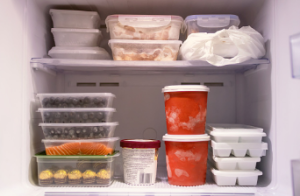Frozen food is a great way to preserve food for future use. Since ancient times, farmers and trappers have kept food in this way.
Air-blast freezing
Air-blast freezing is a commonly used process to freeze food commodities rapidly. The freezing process crystallises water inside the product, making it more decay-resistant. This method can be applied to various food commodities such as fruits, vegetables, meats, cheeses and fish.
 As with any food processing method, air-blast freezing has advantages and disadvantages. The biggest drawback is the cost of obtaining and maintaining liquid nitrogen. Liquid nitrogen is four times more expensive than conventional blast freezing.
As with any food processing method, air-blast freezing has advantages and disadvantages. The biggest drawback is the cost of obtaining and maintaining liquid nitrogen. Liquid nitrogen is four times more expensive than conventional blast freezing.
In addition to the cost of the liquid, the most significant drawback is the need for continuous cooling. If you are in the frozen foods business, you will know that the constant need for liquid nitrogen can be a burden. Fortunately, there are ways to reduce the amount of liquid nitrogen needed.
One of these methods is to use a fluidised bed freezer. These systems use a strong stream of icy air to blast the products. They also ensure a good heat exchange between the product and the air in the freezer.
Using an intelligently designed and positioned airflow can also optimise the quality of the iced-up product. It also lowers the risk of bacterial growth.
Fluidised bed freezing
Fluidised bed freezing is a method used to freeze foods. It involves a porous conveyor belt and cold air in the bed. This technique is used to freeze small and fine foods. The main advantage of using this technique is its ability to freeze foods quickly.
Fluidised bed freezers are typically used for freezing small and fine foods. They can also be used to freeze seafood. Some models are equipped with a frequency-converted ventilator. Another type of freezer is the IQF (Individual Quick Freezing) tunnel freezer.
During the process, a binary nozzle is used to atomise the liquid binder. It is done by generating compressed air and directing it through the material.
Cold air is then directed upwards through the bedplate. As the air flows, it entrains the food particles and speeds up freezing. This type of freezing is best for freezing vegetables and fruits that need to be IQF frozen.
Processors have to learn how to adjust the fluidisation. Using the right amount of fluidisation will help them obtain their products’ best look and appearance. Depending on the product’s size, weight, and fragility, the processor must adjust to the fluidisation to obtain the best results.
Variations in the bedplate design can determine the pressure drop achieved on the bed. Typically, the higher the pressure drop, the better the fluidisation.
In addition, the bedplate’s thickness and the holes’ distribution are critical. Generally, bigger holes mean a higher pressure drop. Learn more at https://www.markwellfoods.co.nz/.
Tunnel freezing
Tunnel freezing is an efficient method of freezing food. It enables you to freeze large quantities of produce quickly without affecting the freshness of the product. This method also reduces the need for extraction fans.
There are several types of tunnel freezers. One type uses liquid nitrogen, and the other uses carbon dioxide. Both are used in the quick freeze process.
The liquid nitrogen is counter-currently blown over the product in a standard tunnel freezer. Newer designs feature multiple spray zones to ensure an even airflow throughout the freezing zone. These more recent models have heat transfer coefficients of up to 1200 W m-2 K-1.
Another type of tunnel freezer uses impingement airflow. High-velocity jets are sprayed over the product. This form of freezing is gentle and helps maintain the texture and appearance of the product.
Plate freezing
Freezing is one of the oldest techniques for preserving food. It’s the best way to keep nutrients while maintaining the taste and texture of the food. Some famous examples include ice cream, iced tea, and fish.
Regarding freezing, there are two main methods: air-blast and plate. Air-blast freezes the product by circulating fast-moving cold air around the product. On the other hand, Plate freezing sandwiches the product between two metal plates. The first method is typically used for vegetables and the second for meats.
To properly freeze your foods, you should use freezers with temperature controls. The temperature should be between -18 deg and 40 deg Fahrenheit. For example, if you’re freezing a fruit, you might need to cool the fruit down to -20 deg F. You should also consider an airless package to keep the contents from getting frostbitten.
Contact freezing
The most common method of contact freezing is plate freezing. Plate freezers are designed with cold metal plates that maintain firm contact with the package surface. These are commonly used for frozen fruit pulps and sauces.
Another popular method of contact freezing is contact belt freezing. These freezers combine a conveyor belt with a plate freezing system. A typical product that is frozen in a belt freezer is egg yolk.
The most critical parameter in comparing different freezing systems is the fantastic rate. It is the ratio of the frozen time and the initial and final temperatures. The faster the air is circulating, the higher the excellent rate.
Another factor affecting the freezing rate is the density of the frozen layer. Thinner food pieces have a greater heat transfer rate than larger or irregular-shaped pieces.
Whether the freezing method is contact or immersion, the temperature of the food at the beginning of the freezing process is known as the “initial freezing temperature” or Tf. In addition, the first ice crystal can form as early as the first minute of the process.
A few empirical equations have been used to calculate the initial freezing temperature of certain foods. For example, a rotator can promote the development of tiny ice crystals, and a thin evaporator can reduce the amount of dehydration.